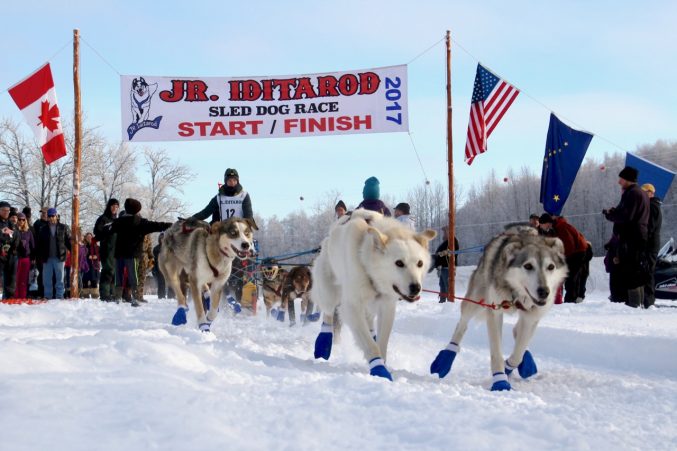This February will mark the 42nd year of the Jr. Iditarod. The Junior, just like the Iditarod, began as a dream. Joe Redington, Sr. dreamed of a long distance race across Alaska to keep the sled dog in Alaska and the old mail routes on the map. It was Eric Beeman who dreamed of a distance race for young mushers to help prepare them for the “Big Iditarod.”
Five years after the Inaugural Iditarod, the juniors had their own Iditarod. It looked quite different than the Jr. Iditarod known today. In 1978, the first year of the Junior, there were two divisions of mushers. The senior division contestants ages 15 to 17, ran 10 dogs for a distance of 40 miles including an overnight camping layover. The Junior division, ages 11 to 14 ran 6 dogs for a distance of 18 miles in a one-day event.
The next year the race was changed to only one division with ages 14 to 17, running 90 miles with a maximum of ten dogs including a required overnight layover. When the race turned three, the distance jumped to 120 miles running from Knik Lake to Point McKenzie. On the fifth running of the race, the layover was moved to Yentna Station Roadhouse where it has been ever since except for 2003 and 2015.
Just as the “Big One” was required to re-route with the start in Fairbanks due to lack of snow and unsafe river conditions, so was the Junior. In 2003 start, the race moved to Glennallen, running a 150-mile loop from the Wolverine Lodge to Sourdough on the Richardson and back. In 2015, the race moved to Cantwell where the teams ran 60 miles out to Alpine Creek Lodge and returned to Cantwell the next day. The majority of the Junior Iditarod races run in the past 30 years have covered a distance of about 150 miles.
Of the past Jr. Iditarod races, six mushers have won in consecutive years. Tim Osmar is the only musher to win three in row. Back to back winners include Lance Barve, Jared Jones, Ramey Smyth, Dusty Whittemore, Ryan Redington and Kevin Harper.
Books about the Jr. Iditarod are relatively few and far between but Ted Woods tells Dusty Whittemore’s story in Iditarod Dream.
In the big picture, the boys have dominated the winner’s circle of the Junior with thirty-four champions while the girls have claimed eight. Females (Christine Delia, Cali King, Ellie Claus, Nicole Osmar, Melissa Owens, Jessica Klejka, Marissa Osmar and Bailey Schaeffer) have won 19% of the Junior races. Compare that to the Iditarod where females (Libby Riddles and Susan Butcher) have won 11% of the “Big One.”
Of the forty-two Junior Iditarod finishes, there have been a handful of really close ones. In 1993, brothers Ramey and Cim Smyth raced to the finish line with Ramey claiming the victory by just thirty-four seconds to defend his championship of the previous year. In 2001, thirty-four seconds was again the margin of victory as Tyrell Seavey sprinted beside his team to the finish line just ahead of Cali King. In 2018, fifty-two seconds separated Bailey Schaeffer and Chandler Wappet at the finish with Schaeffer taking the win.
The closest finish was in 2008. Jessica Klejka dropped down onto Willow Lake just a yard or two in front of Cain Carter. With both teams on the lake and within a quarter mile of the finish banner, Cain urged his dogs to pass, “ON BY, ON BY!” Jessica Klejka urged her team to give it their all, “HIKE, HIKE, HIKE!” Carter and team closed the gap as they overtook Jessica’s sled and wheel dogs. Jessica’s dogs were not to be denied. They added a little more steam and maintained their lead of half a dog team to claim victory by TWO seconds! The canine athletes knew what was at stake and they were every bit as competitive as their young drivers. It was a photo finish equally as exciting as the year Dick Mackey bested Rick Swenson by one second in Nome. Yes, it is the nose of the lead dog that determines the finish.
Over the years there have been five mushers from outside of the United States. Thomas Krejci of Czechoslovakia competed in 1992. In 2000, Kyla Boivin of Dawson City, YT Canada joined the field. Annika Olesen of Yellowknife, NWT Canada raced in 2011. In 2017, Logan McCready DeBruin of Hurlburton, ONT Canada raced. Now in 2019, Ida Kohnert is representing her homeland of Sweden.
The 2019 Jr. Iditarod is sure to be an exciting event. Follow along as the mushers cover the 150-mile racecourse at www.jriditarod.com. The race begins at 10:00 am Saturday, February 23, 2019. Check often for race updates and follow the mushers via tracker.


































